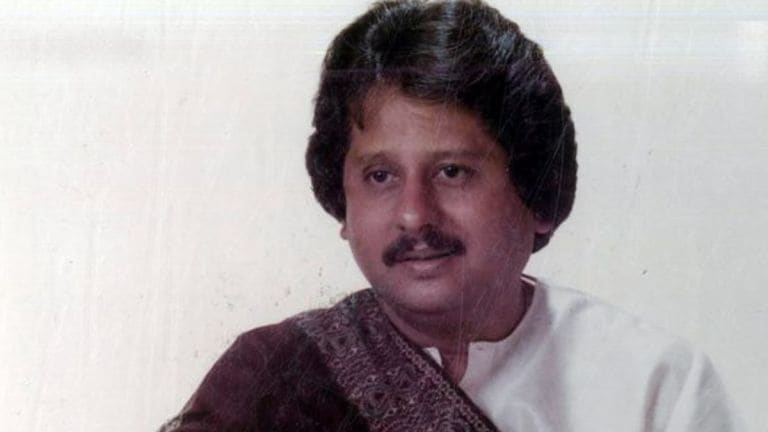RIP : Pankaj Udhas (1951-2024)
Even when Hindi cinema moved away from ghazals, Pankaj Udhas’ concerts continued to have a faithful following

By TH
The soulful voice that soothed broken, Pankaj Udhas passed away after a prolonged illness in Mumbai on February 26 at 72. At the cusp of 1980, when the ‘angry young man’ had sucked melody out of our lives, Udhas, following the footsteps of Mehdi Hasan and Jagjit Singh, popularising ghazals among the youth. Breaking away from the classical format, he liberated the romantic form from Persianised Urdu to convey their pain in a simple verse like Deewaron Se Milkar Rona Achcha Lagta Hai and tweaked the plaintive orchestration to create a new, youthful riff that could declare Mohe Aai Na Jag Se Laaj Main Itna Zor Se Nachi Aaj Ki Ghungroo Toot Gaye.
The image of an elegantly dressed Udhas with a harmonium, not a hair out of place, whispering ever so softly into the mic, Aur Ahista Kijiye Baatein Dhadkain Koi Sun Raha Hoga is etched in the memory of most of those who grew up at a time when Chitrahaar was giving way to music videos and the middle class was opening up to the idea of attending ghazal concerts.
But the song that immortalised Udhas was Chitthi Aayi Hai which he sang for Mahesh Bhatt’s Naam. Released in 1986, the Laxmikant-Pyarelal composition emerged as the anthem of diaspora and migrants. Picturised on Udhas, the song was addressed to the Indian diaspora in the film but such is the verve in Udhas’ voice that Anand Bakshi’s lines became the epitome of every migrant’s yearning for his home. Letters gave way to emails, Skype, and Zoom calls but the song continued to create a lump in the throat every time Udhas raised his pitch to plead Panchhi Pinjra Tod Ke Aaja, Desh Paraya Chhod Ke Aaja.
The song made him a household name after he had already knocked at young hearts with Purab Na Jaiyo Paschhim Na Jaiyyo (Jawaab, 1985). It was followed by Ek Hi Maqsad (1988), where he composed the music and rendered the popular number Chandi Jaisa Rang Hai Tera. The same year, he sang the popular duet Aaj Phir Tumpe Pyar Aaya Hai with Anuradha Paudwal for Feroz Khan’s Dayavan. Another unforgettable heartfelt ditty that continues to evoke pain is Jeeye To Jeeyen Kaise that he rendered for Nadeem Shravan in Saajan (1991). His voice could engage the connoisseur as well as the aesthete in a truck driver. We all have covered many miles listening to a bus driver playing Na Kajre Ki Dhaar (Mohra, 1994) on his rickety cassette player.
Hailing from a family of landlords in Charkhadi town in Rajkot, Udhas was introduced to music by his father, a government servant who loved to play rabab. Udhas started as a tabla player but soon switched to the classical genre under the guidance of Ustad Ghulam Qadir Khan. When the family shifted to Mumbai, Udhas learned under Navrang Nagpurkar, an exponent of the Bhendi Bazar Gharana, who also taught Asha Bhosle. His elder brothers Manhar and Nirmal were already established performers. It was Manhar who introduced Udhas to playback singing. After initial setbacks, Udhas switched to non-film ghazals where he found instant success with albums like Aahat, Muqarrar, Tarannum, and Mehfil.
Many of his popular ghazals revolved around paimana (flagon)and maikada (tavern). Ghazals like Ek Taraf Uska Ghar, Ek Taraf Maikada and Sharab Cheez Hi Aisi Hai became an essential feature of his concerts but he also faced criticism for normalising boozing. Udhas held that these were metaphors for the intoxication of the divine in Sufi poetry but the argument didn’t always hold as he sang Ek Ek Ho Jaye Phir Ghar Chale Jaana with Kishore Kumar in Ganga Jamunaa Saraswati (1988). Music companies also pandered to this image by naming his albums Nasha, Paimana, and Madhosh.
Because of his deep emotional connection with the diaspora, the Padma Shri was always in great demand for overseas concerts, and performed at the Royal Albert Hall in London and Madison Square in New York. Even when Hindi cinema moved away from ghazals, his concerts continued to have a faithful following.



